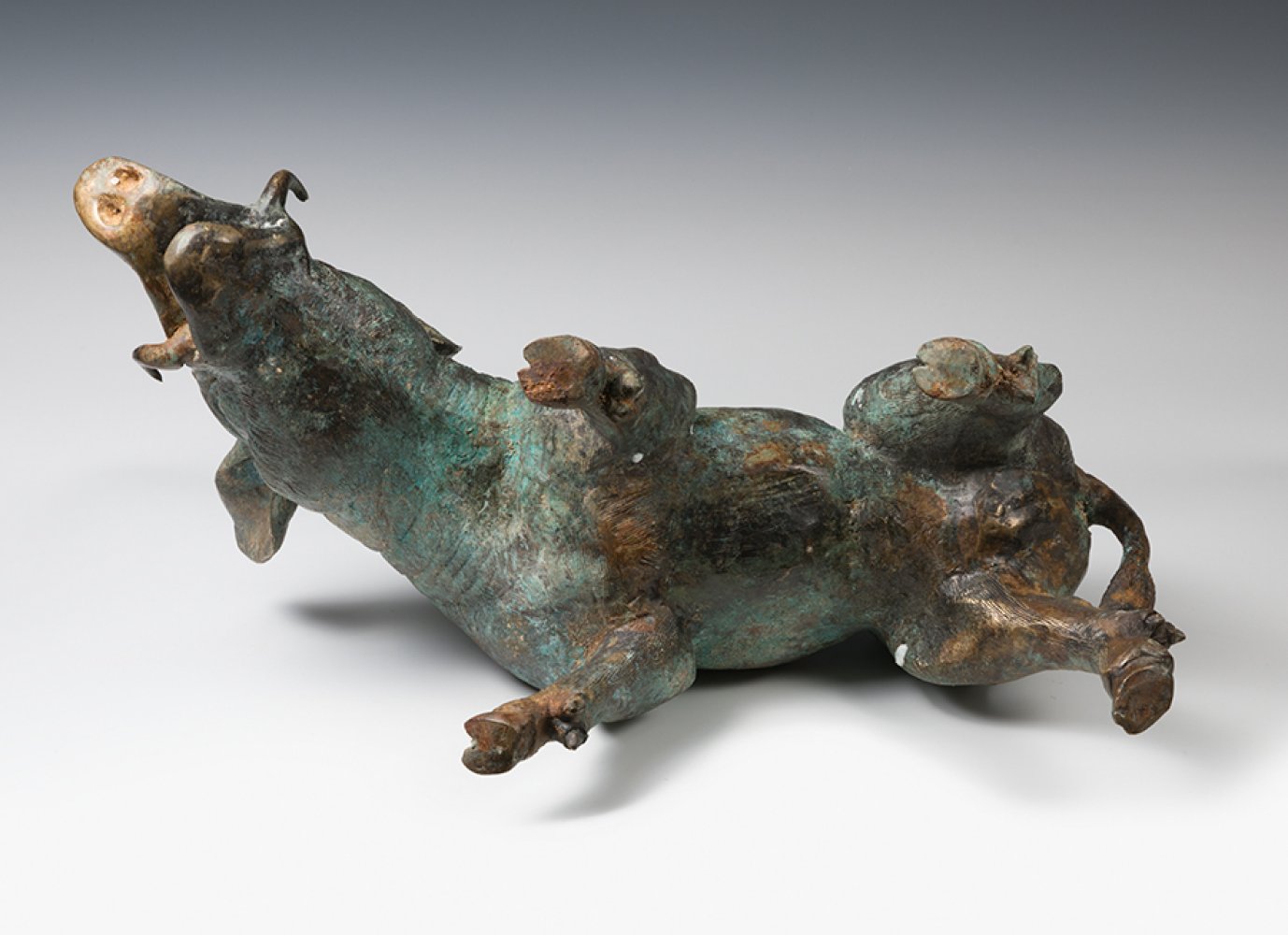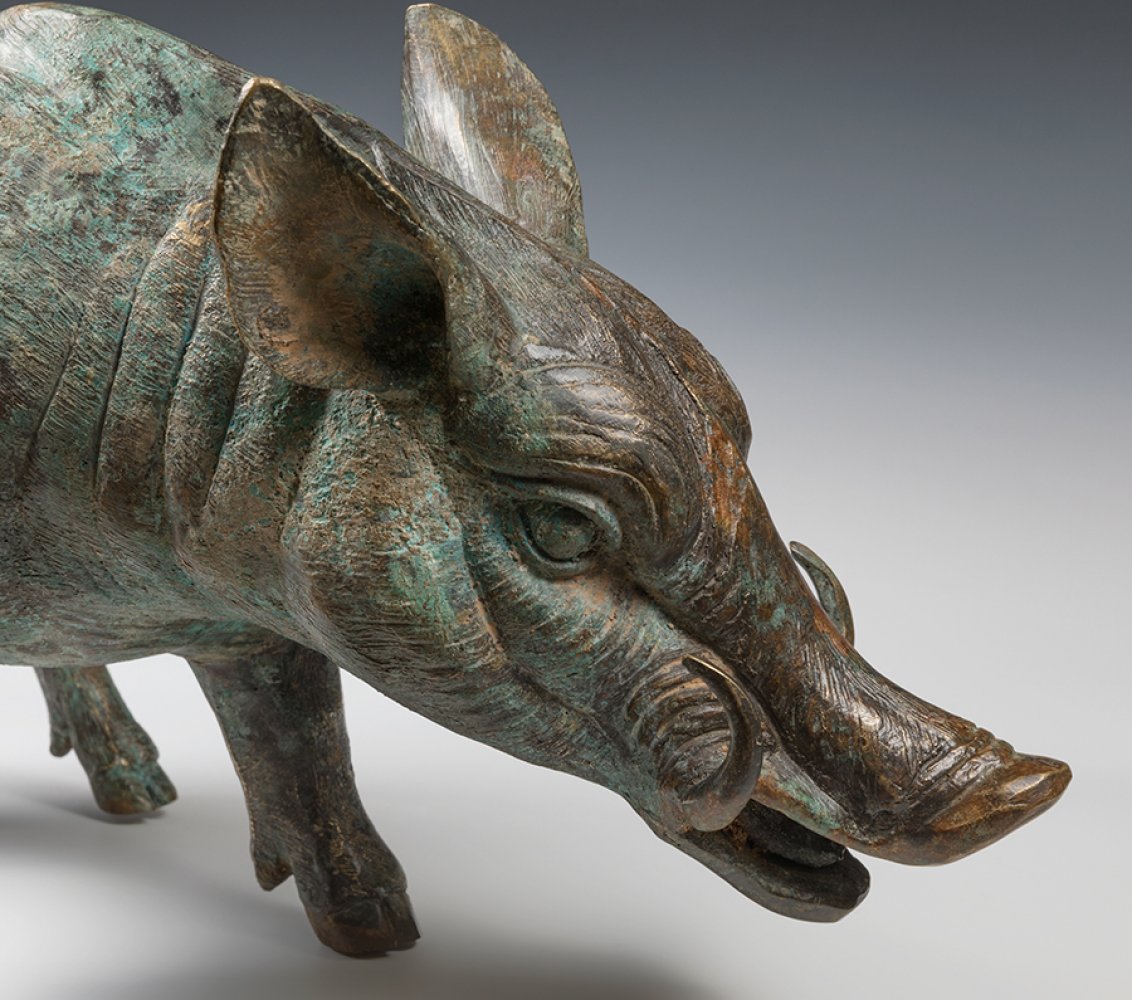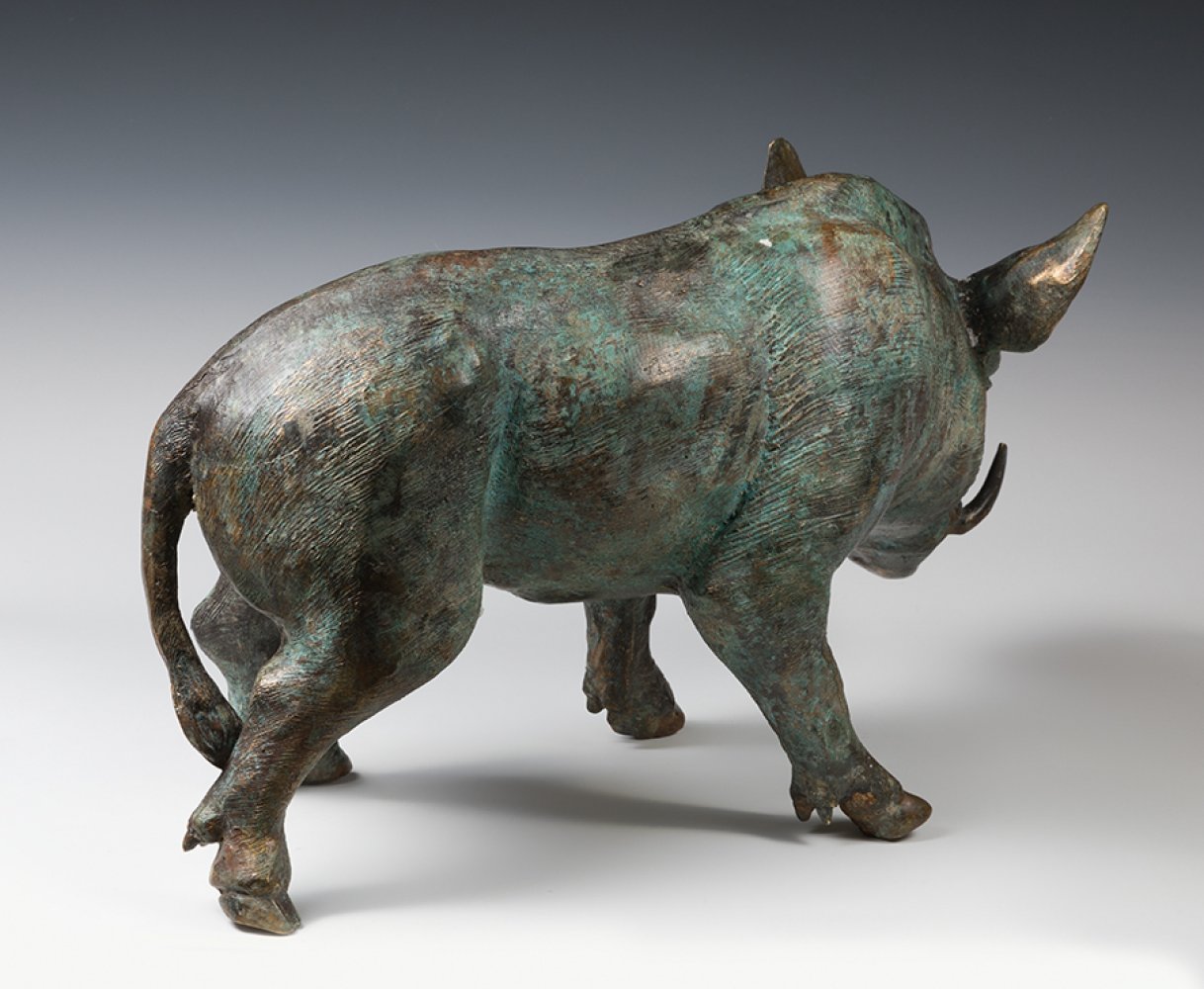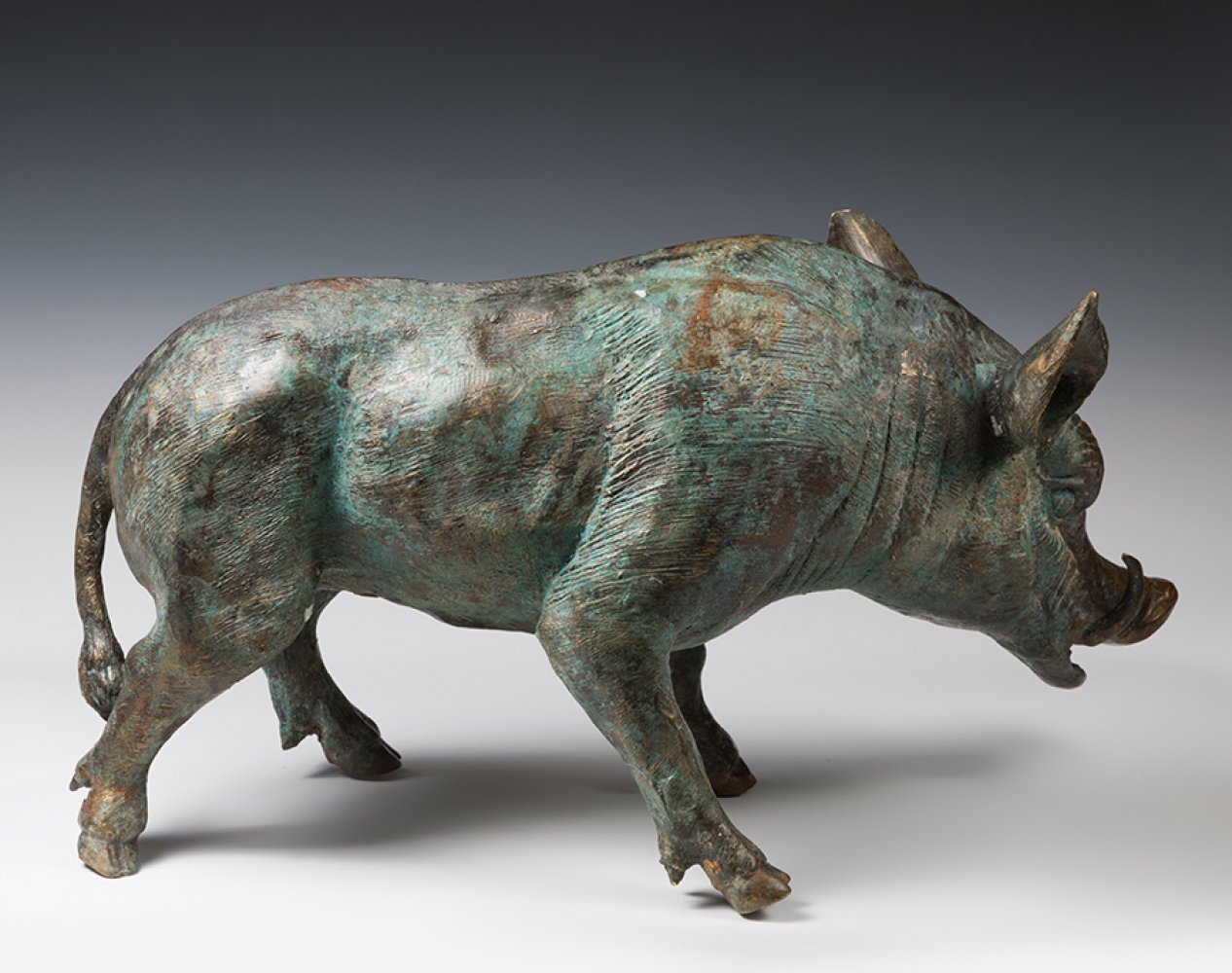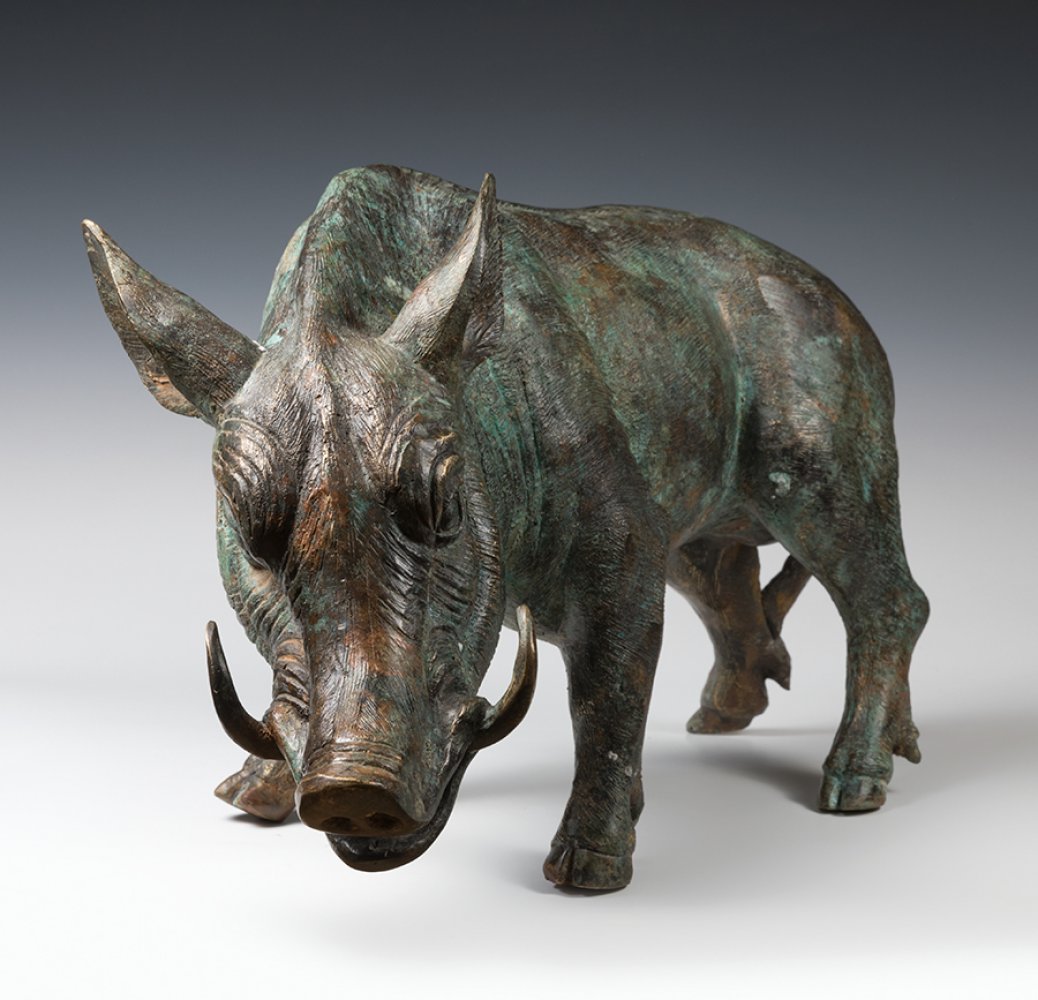7
Italian school of the 18th-19th century, following models of Ancient Rome.Bronze.Measurements: 28
1/6
Description
Italian school of the 18th-19th century, following models of Ancient Rome.
Bronze.
Measurements: 28 x 52 x 21 cm.
Although this sculpture of a wild boar was made in the 18th-19th centuries, it follows classical models based on the art of Ancient Rome. According to historians of Classical Antiquity, the boar was the emblem of one of the Roman legions, probably the IX, and its antiquity dates back to 200 years before Christ. Particularly noteworthy is the careful workmanship of the carefully individualised fur, as well as the truthfulness of the animal's face and legs.
The Romans brought two important innovations to the world of sculpture: portraiture and historical relief, neither of which existed in the Greek world. However, they followed Greek models for much of their sculptural production, a base which in Rome was combined with the Etruscan tradition. After the first contacts with Classical Greece through the Magna Graecia colonies, the Romans conquered Syracuse in 212 BC, a rich and important Greek colony in Sicily, which was adorned with a large number of Hellenistic works. The city was sacked and its art treasures taken to Rome, where the new style of these works soon replaced the Etruscan-Roman tradition that had prevailed until then. Cato himself denounced the looting and decoration of Rome with Hellenistic works, which he considered a dangerous influence on native culture, and deplored the Romans' applause of statues from Corinth and Athens, while ridiculing the decorative terracotta tradition of ancient Roman temples. However, these oppositional reactions were in vain; Greek art had subdued Etruscan-Roman art in general, to the extent that Greek statues were among the most coveted prizes of war, being displayed during the triumphal procession of the conquering generals.
Bronze.
Measurements: 28 x 52 x 21 cm.
Although this sculpture of a wild boar was made in the 18th-19th centuries, it follows classical models based on the art of Ancient Rome. According to historians of Classical Antiquity, the boar was the emblem of one of the Roman legions, probably the IX, and its antiquity dates back to 200 years before Christ. Particularly noteworthy is the careful workmanship of the carefully individualised fur, as well as the truthfulness of the animal's face and legs.
The Romans brought two important innovations to the world of sculpture: portraiture and historical relief, neither of which existed in the Greek world. However, they followed Greek models for much of their sculptural production, a base which in Rome was combined with the Etruscan tradition. After the first contacts with Classical Greece through the Magna Graecia colonies, the Romans conquered Syracuse in 212 BC, a rich and important Greek colony in Sicily, which was adorned with a large number of Hellenistic works. The city was sacked and its art treasures taken to Rome, where the new style of these works soon replaced the Etruscan-Roman tradition that had prevailed until then. Cato himself denounced the looting and decoration of Rome with Hellenistic works, which he considered a dangerous influence on native culture, and deplored the Romans' applause of statues from Corinth and Athens, while ridiculing the decorative terracotta tradition of ancient Roman temples. However, these oppositional reactions were in vain; Greek art had subdued Etruscan-Roman art in general, to the extent that Greek statues were among the most coveted prizes of war, being displayed during the triumphal procession of the conquering generals.
Auction Details
Shipping
T&Cs & Important Info
Ask seller a question
Italian school of the 18th-19th century, following models of Ancient Rome.
Bronze.
Measurements: 28 x 52 x 21 cm.
Although this sculpture of a wild boar was made in the 18th-19th centuries, it follows classical models based on the art of Ancient Rome. According to historians of Classical Antiquity, the boar was the emblem of one of the Roman legions, probably the IX, and its antiquity dates back to 200 years before Christ. Particularly noteworthy is the careful workmanship of the carefully individualised fur, as well as the truthfulness of the animal's face and legs.
The Romans brought two important innovations to the world of sculpture: portraiture and historical relief, neither of which existed in the Greek world. However, they followed Greek models for much of their sculptural production, a base which in Rome was combined with the Etruscan tradition. After the first contacts with Classical Greece through the Magna Graecia colonies, the Romans conquered Syracuse in 212 BC, a rich and important Greek colony in Sicily, which was adorned with a large number of Hellenistic works. The city was sacked and its art treasures taken to Rome, where the new style of these works soon replaced the Etruscan-Roman tradition that had prevailed until then. Cato himself denounced the looting and decoration of Rome with Hellenistic works, which he considered a dangerous influence on native culture, and deplored the Romans' applause of statues from Corinth and Athens, while ridiculing the decorative terracotta tradition of ancient Roman temples. However, these oppositional reactions were in vain; Greek art had subdued Etruscan-Roman art in general, to the extent that Greek statues were among the most coveted prizes of war, being displayed during the triumphal procession of the conquering generals.
Bronze.
Measurements: 28 x 52 x 21 cm.
Although this sculpture of a wild boar was made in the 18th-19th centuries, it follows classical models based on the art of Ancient Rome. According to historians of Classical Antiquity, the boar was the emblem of one of the Roman legions, probably the IX, and its antiquity dates back to 200 years before Christ. Particularly noteworthy is the careful workmanship of the carefully individualised fur, as well as the truthfulness of the animal's face and legs.
The Romans brought two important innovations to the world of sculpture: portraiture and historical relief, neither of which existed in the Greek world. However, they followed Greek models for much of their sculptural production, a base which in Rome was combined with the Etruscan tradition. After the first contacts with Classical Greece through the Magna Graecia colonies, the Romans conquered Syracuse in 212 BC, a rich and important Greek colony in Sicily, which was adorned with a large number of Hellenistic works. The city was sacked and its art treasures taken to Rome, where the new style of these works soon replaced the Etruscan-Roman tradition that had prevailed until then. Cato himself denounced the looting and decoration of Rome with Hellenistic works, which he considered a dangerous influence on native culture, and deplored the Romans' applause of statues from Corinth and Athens, while ridiculing the decorative terracotta tradition of ancient Roman temples. However, these oppositional reactions were in vain; Greek art had subdued Etruscan-Roman art in general, to the extent that Greek statues were among the most coveted prizes of war, being displayed during the triumphal procession of the conquering generals.
29th December - Old Masters
Sale Date(s)
Venue Address
Aragón 346, Barcelona
Calle Velázquez 7, Madrid
Carrer de Cirilo Amorós 55, Valencia
Barcelona
08009
Spain
General delivery information available from the auctioneer
Setdart offers Worldwide shipping
PICK UP IN ROOM: You can come and pick up your lots in our offices (Barcelona, Madrid or Valencia). At the moment of the withdrawal, you will be able to accept the current conditions of the lot by means of a document that you will sign.
YOU CAN SEND ANOTHER PERSON TO PICK UP: This person must present a signed authorization that you can find in our web page by accessing from BUY AT SETDART- LOGISTICS-DOWNLOAD AUTHORIZATION DOCUMENT. You can also send an e-mail with the requested data in AUTHORIZATION DOCUMENT to admin@setdart.com
Important Information
25% buyer´s premium
21% buyer´s premium at www.setdart.com














